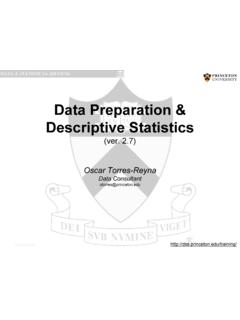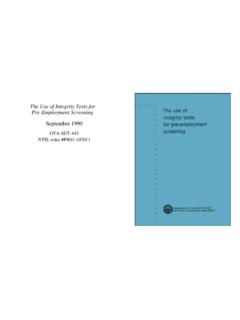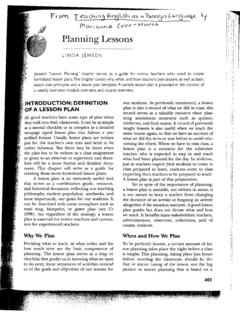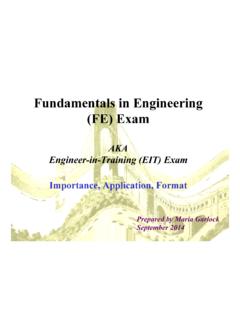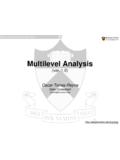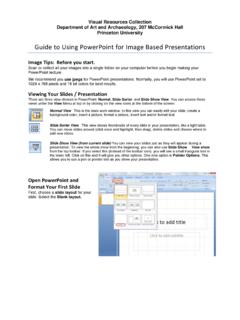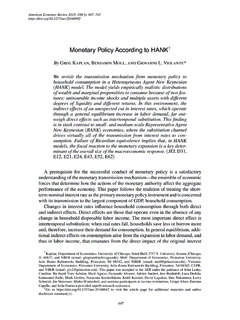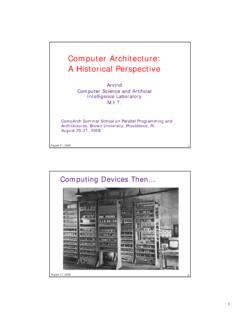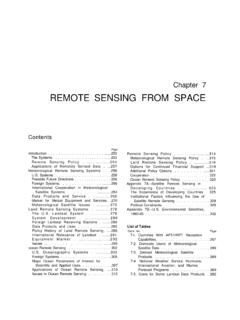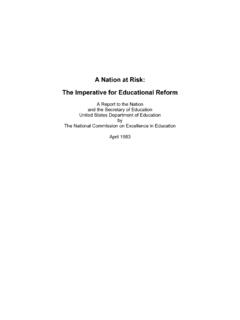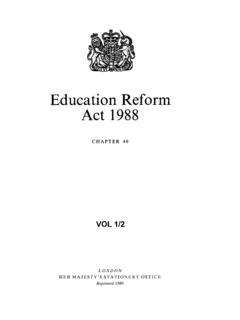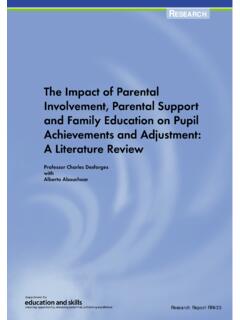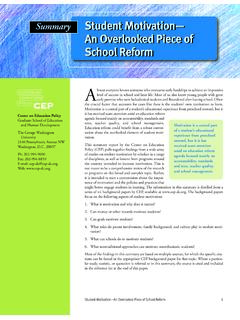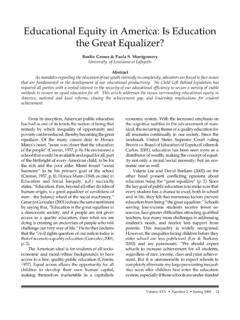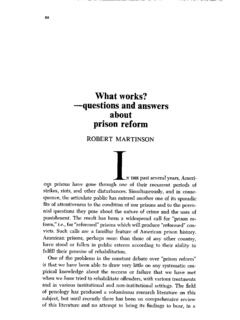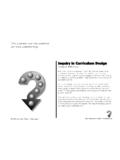Transcription of Lessons From the Past: A History of Educational Testing in ...
1 CHAPTER 4 Lessons From the Past: A History of Educational Testingin the United ..** **. **o..*..*. **..**. **.. e * * * ..Achievement Tests Come to American Schools: 1840 to 1875 ..Overview.*..e*..*. *..*..*o*..Demography, Geography, and Bureaucracy ..The Logic of Testing ..Effects of Test Usel ..Science in the Service of Management: 1875 to 1918., ,0 ..l ..l ..,,,..**,..*..,.*..**.*Issues of Equity and Efficiency..An Intellectual Bridge..Mental Testing .. Testing in Context..Managerial Efficiency..Achievement and Ability Vie for Acceptability..Experimentation and Practice*o..*.. *e..*..*..6, ..*..**. **. o.*The Influence of Colleges..World War I**e..**. *.. *.*e*e. e*..*. +*..*.. o * .. * * .. Testing Through World War II: 1918 to 1945..Overview..A Legacy of the Great War..The Iowa Program..Multiple Choice: Dawn of an Era..Critical Questions..College Admissions Standards: Pressure Mounts.
2 Testing and Survey Research.. Testing and World War II..Equality, Fairness, and Technological Competitiveness: 1945 to 1969 ..Overview..Access Expands..Developments in Technology..Race and Educational Opportunity..Recapitulation..10310410410 4108109110111111112114115116118118119120 1201211221241241251261271271271281291301 31 BoxBox4-A. Mental Testers: Different Views..113 Figure4-1. Annual Immigration to the United States: 1820-60..105 CHAPTER 4 Lessons From the Past: A History ofEducational Testing in the United StatesHighlightsSince their earliest administration in the mid-19th century, standardized tests have been used to assessstudent learning, hold schools accountable for results, and allocate Educational opportunities the History of Educational Testing , advances in test design and innovations in scanning andscoring technologies helped make group-administered Testing of masses of students more efficient Testing is not a new phenomenon.
3 From the outset, standardized tests were used as aninstrument of school reform and as a prod for student written Testing began to replace oral examinations at about the same time that American schoolschanged their mission from servicing the elites to educating the masses. Since then tests have remaineda symbol of the American commitment to mass education, both for their perceived objectivity and fortheir undeniable standardized tests were seen by some as instruments of fairness and scientific rigor appliedto education, they were soon put to uses that exceeded the technical limits of their design. A reviewof the History of achievement Testing reveals that the rationales for standardized tests and thecontroversies surrounding test use are as old as Testing burgeoning use of tests during the past to measure student progress, hold stu-dents and their schools accountable, and moregenerally solidify various efforts to improve school-ing-has signified to some observers a.
4 Pro-found change in the nature and use of Testing .. "lBut the use of tests for the dual purposes ofmeasuring and influencing student achievement isnot a historical anomaly. The three principal ration-ales for student Testing --classroom feedback; sys-tem monitoring;and selection, placement, their roots in practices thatbegan in the United States more than 150 years many of the points that frame the Testing debatetoday, such as the potential for test misuse, echoarguments that have been sounded since the begin-ning of standardized student chapter surveys the evolution of studenttesting in American schools, and develops fourthemes:Tests in the United States have always beenused to ascertain the effects of schooling onchildren, as well as to manage school systemsand influence curriculum and pedagogy. Testsdesigned and administered from beyond class-rooms have always been more useful toadministrators, legislators, and other schoolauthorities than to classroom teachers or stu-dents, and have often been most eagerlyapplied by those seeking school historical use of standardized tests in theUnited States reflects two fundamentally Amer-ican beliefs about the organization and alloca-tion of Educational opportunities: fairness andefficiency.
5 The fairness principle involves, forexample, assurances to parents that their chil-dren are offered opportunities similar to thosegiven children in other schools or neighbor-hoods. Efficiency refers to the orderly provi-sion of Educational services to all have been the foundation blocks for theIGmrge quoted in Edward B. Fiske, America s lkst Mania, The New York Apr. 10, 1988, section 12, p. 18. See ch. 3 of this reportfor a detailed account of the rise of Testing in the 1970s and 0 - 92 - 8 QL 3-103-104 . Testing in American Schools: Asking the Right ,American system of mass public schooling; Testing has been a key ingredient of the Testing has engendered tension andcontroversy over its effects. These tensionsreflect the centrality of schooling in Americanlife, and competing visions of the purposes andmethods of education within American plural-ism. Demand for tests stems in large part fromdemand for fair treatment of all students; theuse of tests, however, especially for sortingand credentialing of young persons, has al-ways raised its own questions of long as schooling continues to play acentral role in American life, and as long astests are used to assess the quality of education, Testing will occupy a prominent place on thepublic policy agenda.
6 The search for betterassessment technologies will continue to befraught with controversies that have as much todo with Testing per se as with conflictingvisions of American ideals and chapter focuses on Testing through fourchronological periods. The first section begins withthe initial Educational uses of standardized writtenexaminations in the mid-19th century and continuesthrough the development of mental (intelligence)measurement near the end of that century. The nextsection covers the onset of intelligence and achieve-ment Testing in the schools, a movement spurredlargely by managerial and administrative concernsand supplied, in large part, with the newly develop-ing tools of scientific Testing . The third sectionfocuses on trends in Educational Testing from the endof World War I through the end of World War II, aperiod marked by important technological advancesas well as refinements in the art and science oftesting.
7 The last section of this chapter is a discus-sion of the pivotal role of Testing in the struggle forracial equality, increased Educational access, andinternational technological competitiveness in theyears after World War Tests Come toAmerican Schools: 1840 to 1875 OverviewThe period from 1840 to 1875 established severalmain currents in the History of American educationaltesting. First, formal written Testing began to replaceoral examinations administered by teachers andschools at roughly the same time as schools changedtheir mission from servicing the elite to educatingthe masses. Second, although the early standardizedexaminations were not designed to make validcomparisons among children and their schools, theywere quickly used for that purpose. Motivated in partby a deep commitment to fairness in educationalopportunities, the use of tests soon became contro-versial precisely over challenges to their fairness asa basis for certain types of comparisons-challengesleveled by some teachers and school leaders, al-though not by the most active crusaders on behalf offree and universal education.
8 Third, the early writtenexaminations focused on the basics-the majorschool subject--even though the objectives ofschooling were understood to be considerably broaderthan these , from their inceptionstandardized tests were perceived as instruments ofreform:2 it was taken as an article of faith thattest-based information could inject the neededadrenalin into a rapidly bureaucratizing , Geography, and BureaucracyTests of achievement have always been part of theexperience of American school children. In thecolonial period, school supervisors administeredoral examinations to verify that children werelearning the prescribed material. Later, as schoolsystems grew in size and complexity, the design,purposes, and administration of achievement testingevolved in an effort to meet new demands. Wellbefore the Civil War, schools used externallymandated written examinations to assess studentprogress in specific curricular areas and to aid in a2,,Rtiom,, mu _ t.
9 Diffemt ~ople, eW~y wi~ re~t to education. In this repo~ the word is titended neu~Y, , ~ change, although it clearly connotes the intention to improve, upgrade, or widen children s Educational experiences. The possibility that goodintentions can lead to unintended consequences is the central theme in such works as Michael B. Katq of (Cambridge,MA: Harvard University Press, 1968). See also Lawrence Crernim of Yorlq NY Vintage Books, 1964) for an even broader exploration of change, , as transformation of the school. Chapter 4-- Lessons From the Past: A History of Educational Testing in the United States l 105variety of administrative and policy Asearly as 1838 American educators began articulatingideas that would soon be translated into the formalassessment of student 4-l Annual Immigration to the United States:1820-60 Thousands oo~What were the main factors that led to this interestin Testing ?
10 What were the main purposes for Testing ?Some of the answers lie in the demography andpolitical philosophy that shaped the 19th centuryAmerican 1820 and 1860 American cities grew ata faster rate than in any other period in History ,as the number of cities with a population of over5,000 increased from 23 to That same periodsaw an average annualimmigration of roughly125,000 newcomers, mostly Europeans (see figure4-1).5 Coincident with this immigration and urbani-zation, the idea of universal schooling took hold. By1860 ..a majority of the States had establishedpublic [primary] school systems, and a good half ofthe nation s children were already getting someformal education. 6 Some States, like Massachu-setts, New York, and Pennsylvania, were movingtoward free secondary school as it is difficult to establish a causal linkbetween these demographic and Educational changes,surely one thing that attracted Europeanimmigrantswas the ideal of opportunity embodied in theAmerican approach to universal schooling.
